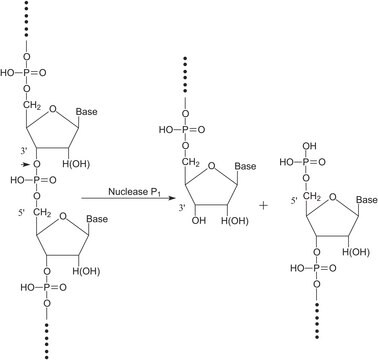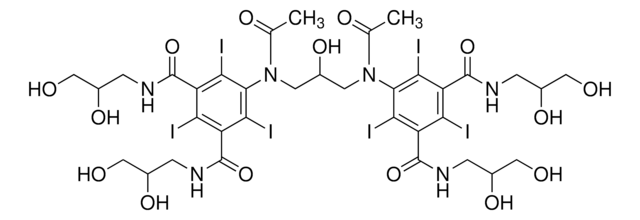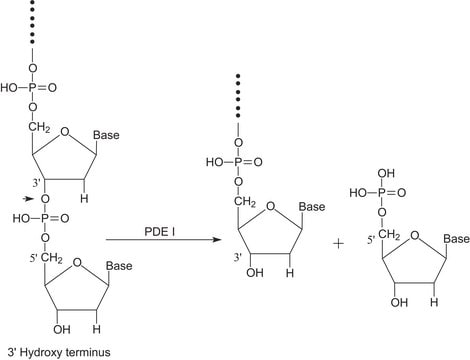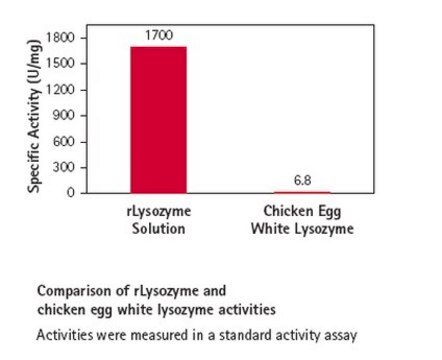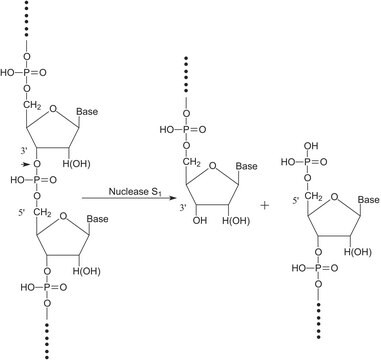E8263
Benzonase® Nuclease, ultrapure
≥250 units/μL, ≥99% (SDS-PAGE), recombinant, expressed in E. coli, buffered aqueous glycerol solution, ultrapure grade
Synonym(s):
Endonuclease from Serratia marcescens
Sign Into View Organizational & Contract Pricing
All Photos(1)
About This Item
CAS Number:
MDL number:
UNSPSC Code:
12352204
NACRES:
NA.54
Recommended Products
biological source
Serratia marcescens
Quality Level
recombinant
expressed in E. coli
grade
ultrapure grade
Assay
≥99% (SDS-PAGE)
form
buffered aqueous glycerol solution
mol wt
30 kDa
concentration
≥250 units/μL
application(s)
research use
shipped in
wet ice
storage temp.
−20°C
Looking for similar products? Visit Product Comparison Guide
Application
The enzyme has been used for an assay to detect the amount of Tf1 RNA that is protected from degradation by the nuclease, Benzonase. The Tf1 element of Schizosaccharomyces pombe is a long terminal repeat-containing retrotransposon that encodes functional protease, reverse transcriptase, and integrase proteins. It has also been used in the fractionation of nuclear pellet and nuclear extract obtained from cell lysates.
Ultrapure benzonase nuclease, or Endonuclease from Serratia marcescens, has been used in a study to assess the effect of sodium dodecylbenzenesulfonate and antifoaming agents on the endonuclease activity of Serratia marcescens. Endonuclease from Serratia marcescens has also been used in a study to investigate the structure of chromatin subunits.
Used for the removal of nucleic acid from protein samples.
Biochem/physiol Actions
Benzonase® is a genetically engineered endonuclease from Serratia marcescens. The protein is a dimer of 30 kDa subunits with two essential disulfide bonds. This endonuclease attacks and degrades all forms of DNA and RNA (single stranded, double stranded, linear and circular) and is effective over a wide range of operating conditions. It completely digests nucleic acids to 5′- monophosphate terminated oligonucleotides 3 to 5 bases in length. This is ideal for the removal of nucleic acids from recombinant proteins. It can also be used for applications where complete digestion of nucleic acids is desirable. It also reduces viscosity in protein extracts and prevents cell clumping. Pre-treatment of a protein sample with this enzyme improves its resolution on 2D gel electrophoresis by eliminating any bound nucleic acids. The optimum pH for enzyme activity is found to be 8.0-9.2.
Digests native or heat-denatured DNA and RNA.
Unit Definition
One unit will digest sonicated salmon sperm DNA to acid-soluble oligonucleotides equivalent to a ΔA260 of 1.0 in 30 min at pH 8.0 at 37 °C (reaction volume 2.625 ml).
Physical form
Solution in 50% glycerol containing 20 mM Tris HCl, pH 8.0, 2 mM MgCl2, and 20 mM NaCl.
Legal Information
Benzonase® Nuclease is supplied by Merck KGaA, Darmstadt, Germany and/or its affiliates.
Benzonase is a registered trademark of Merck KGaA, Darmstadt, Germany
Storage Class Code
10 - Combustible liquids
WGK
WGK 1
Flash Point(F)
Not applicable
Flash Point(C)
Not applicable
Personal Protective Equipment
dust mask type N95 (US), Eyeshields, Gloves
Choose from one of the most recent versions:
Already Own This Product?
Find documentation for the products that you have recently purchased in the Document Library.
Customers Also Viewed
Laure Teysset et al.
Journal of virology, 77(9), 5451-5463 (2003-04-15)
The Tf1 element of Schizosaccharomyces pombe is a long terminal repeat-containing retrotransposon that encodes functional protease, reverse transcriptase, and integrase proteins. Although these proteins are known to be necessary for protein processing, reverse transcription, and integration, respectively, the function of
Daria V Babushok et al.
Human mutation, 28(6), 527-539 (2007-02-20)
Long interspersed nucleotide element (LINE)-1 retrotransposon (L1) has emerged as the largest contributor to mammalian genome mass, responsible for over 35% of the human genome. Differences in the number and activity levels of L1s contribute to interindividual variation in humans
T K Ball et al.
Gene, 57(2-3), 183-192 (1987-01-01)
We are studying exoproteins of the enteric bacterium Serratia marcescens as a model system for the release of extracellular proteins from the cell. In this work we report the cloning of the gene for a secreted nuclease from S. marcescens
T K Ball et al.
Nucleic acids research, 20(19), 4971-4974 (1992-10-11)
The role of the two disulfide bonds found in the Serratia marcescens nuclease were tested by site directed mutagenesis and were found essential for nuclease activity, although slight residual activity remained. The requirement for disulfide bond formation may play a
Romain Da Costa et al.
Investigative ophthalmology & visual science, 57(13), 5326-5334 (2016-10-27)
Gene therapies to treat eye disorders have been extensively studied in the past 20 years. Frequently, adeno-associated viruses were applied to the subretinal or intravitreal space of the eye to transduce retinal cells with nucleotide sequences of therapeutic potential. In
Articles
This page lists nine frequently asked questions and answers about Benzonase® Nuclease.
Our team of scientists has experience in all areas of research including Life Science, Material Science, Chemical Synthesis, Chromatography, Analytical and many others.
Contact Technical Service



